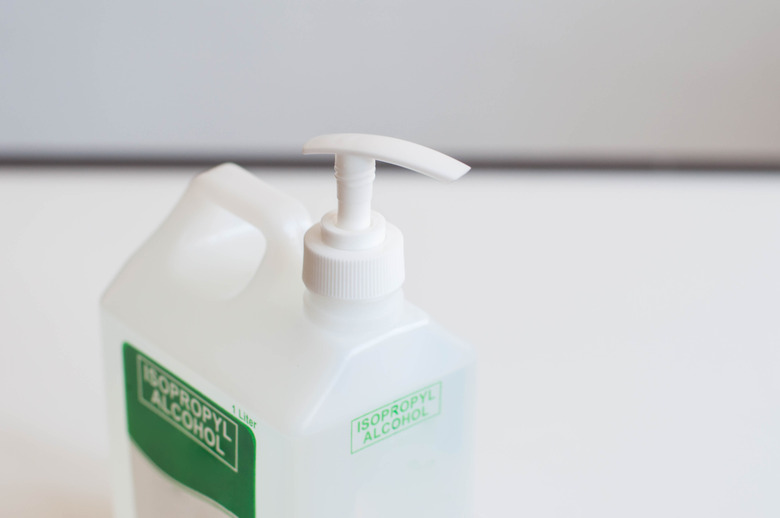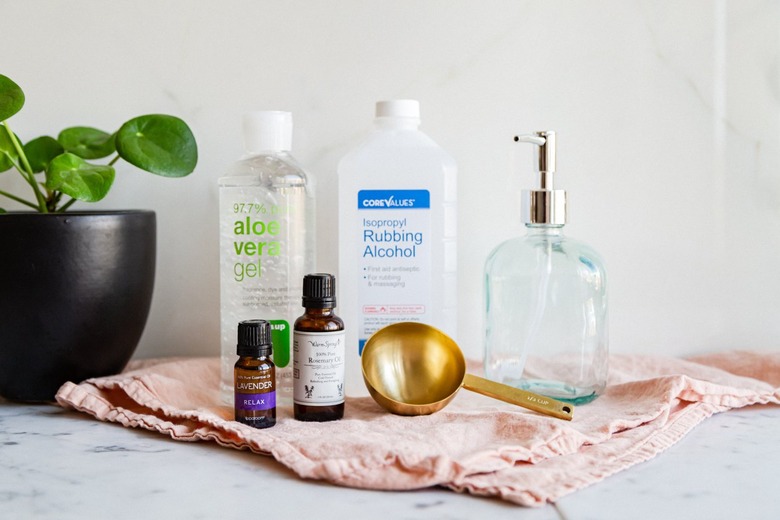How To Dispose Of Rubbing Alcohol
We may receive a commission on purchases made from links.
Most people don't think much about how many potentially dangerous chemicals are in their medicine cabinets and garages until it's time to dispose of them. That's when things get complicated. Every municipality has its own rules for disposal, and some chemicals are much more regulated (i.e. dangerous) than others. While products like pesticides and paint thinners contain toxic materials that require special handling, rubbing alcohol is one household chemical that you can safely dispose of on your own. That doesn't mean that you can simply toss the bottle in your recycling bin, though. Here's how to dispose of rubbing alcohol properly.
What Is Rubbing Alcohol?
What Is Rubbing Alcohol?
Commonly used as a disinfectant, rubbing alcohol is isopropyl alcohol that has been slightly diluted with water. How much water has been added determines the strength of the solution. The two concentrations you're most likely to see on your drug store's shelves are 70 percent rubbing alcohol (70 parts alcohol and 30 parts water) and 99 percent rubbing alcohol (99 parts alcohol and 1 part water).
The concentration of your rubbing alcohol may matter when you're using it to clean. Contrary to what you might assume, a lower concentration of isopropyl alcohol can actually be a more effective disinfectant because the higher water content slows evaporation and gives the alcohol time to kill bacteria. However, the concentration doesn't matter when it comes to disposal. All kinds of rubbing alcohol can be disposed of in the same ways.
How to Safely Dispose of Rubbing Alcohol
How to Safely Dispose of Rubbing Alcohol
It's generally safe to dispose of rubbing alcohol by pouring it down a household drain, but check your local regulations to make sure. To safely pour rubbing alcohol down your household drain, run the water and slowly pour the alcohol into the drain. Continue running the water for a few seconds. Even if your home uses a septic system, it should be safe to pour a small amount of rubbing alcohol down a drain. Dumping gallons of alcohol into the septic tank, however, could disrupt its bacterial balance, but the contents of one bottle shouldn't cause a major problem.
Dumping rubbing alcohol down the drain, especially in large quantities, is prohibited in some areas. If that's the case for you, keep your leftover or expired rubbing alcohol in a sealed container and drop it off at a nearby hazardous waste collection site. Contact your local waste management office for help finding a nearby hazardous waste disposal facility.
Warning
Alcohol is flammable, so if you're collecting your leftover rubbing alcohol in a sealed container until you can dispose of it, keep it in a well-ventilated area that's away from any fuel sources.
Ways to Use Up Leftover Rubbing Alcohol
Ways to Use Up Leftover Rubbing Alcohol
While it's perfectly safe to dispose of rubbing alcohol in a household drain, there may be more beneficial ways to use up any excess alcohol. In addition to disinfecting, rubbing alcohol has a few other common practical applications around the home. Use leftover rubbing alcohol for things like:
- Cleaning glass
- Disinfecting and sanitizing surfaces
- Removing adhesive
- Deterring pests
To use rubbing alcohol as a glass cleaner, mix approximately 1 part white vinegar, 4 parts rubbing alcohol and 16 parts water in a new, clean spray bottle. (Reusing a spray bottle that has previously held some kind of liquid may introduce chemicals into your DIY glass cleaner that you don't want to use on glass surfaces.) Spritz the solution on windows or mirrors and use newspaper to get a streak-free shine.
Rubbing alcohol can also be an effective adhesive remover. To get rid of a stubborn sticker or soften a patch of hardened glue, pour a little rubbing alcohol over it or place a cotton ball soaked with rubbing alcohol over the area. Let it sit for 10 minutes or so and then buff away the adhesive with a cloth or use a rubber scraper to lift it.
Some home gardeners even use rubbing alcohol as an insecticide. Mix equal parts rubbing alcohol and water in a spray bottle, then add a squirt of dish soap. The soap acts as a surfactant, helping the alcohol solution adhere to the plant long enough for it to be effective. Spray the liquid directly onto a small section of an infested plant. Check the area after a day or two to evaluate whether the solution caused any damage to the plant itself; if not, you can treat the entire plant with your rubbing alcohol spray.

